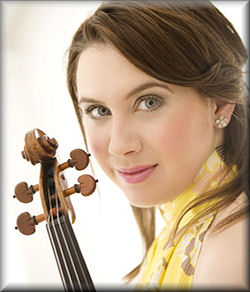This latest instalment in Hyperionís Romantic Violin Concerto series
brings us two concertos which, in a sweeping generalisation, might
be regarded as works more notable for their singing qualities than
for their display opportunities. I mean no disrespect to Glazunov
or to his eminently attractive concerto when I say that pride of place
must go to the concerto by the Swiss composer, Othmar Schoeck for,
after all, this is a work that you will be lucky to encounter in the
concert hall and even recordings of it are not exactly legion.
Schoeck is today known principally for his lieder and, as
Calum MacDonald relates in his highly informative notes, his output
for orchestra sans voice was not extensive. The present concerto
was his most substantial concert work and was written when he had
come under the spell of the Hungarian violinist, Stefi Geyer. Though
Geyer did not premiere the work she did take it up later and thereís
a 1947 recording by her, conducted by Volkmar Andrae, who conducted
one of the workís earliest performances. Iíve not heard that recording
and I hope itís still available for Rob Barnett was enthusiastic about
it (review).
Schoeckís concerto really does deserve a wide audience for it is a
hugely attractive work and for much of the time the violin spins lines
of enchanting lyricism; indeed, itís one of those concertos in which
the soloist is rarely silent. The first movement, in which the musical
language is warm and romantic, has some forthright episodes but for
the most part itís lyricism that predominates and the solo violin
sings and soars most appealingly. The second movement does seem to
have some darker undercurrents, which are confined to the orchestra,
and there are some passionate moments but again oneís ear is caught
mainly by the long melodic lines that Schoeck gives his soloist; not
for nothing was he a notable composer of lieder. Around the
seven-minute mark thereís a significant episode that anticipates the
finale. This last movement eventually follows on without a break and
this starts in a lively vein. Both soloist and orchestra project this
dancing music most winningly. However, Schoeck is seemingly unable
to resist the temptation of a slower, more reflective episode Ė which,
admittedly, is rather lovely Ė and thereafter the music alternates
between reappearances of the lively material and more ruminative passages.
In fact, though it began the movement the lively music never really
completely asserts itself and it comes as a mild surprise when, after
all the lyrical music thatís gone before, both in the finale and in
the concerto as a whole, Schoeck ends the piece in a lively fashion.
Rob Barnett suggested that perhaps there is too much lyrical music
in this work for its own good and itís hard to disagree. However,
give me that any day in preference to the empty fiddling fireworks
in some of the nineteenth-century concertos that virtuosi have so
often used as vehicles to show off their technical prowess. ChloŽ
Hanslip seems to me to make an excellent job of the solo part; the
long, singing lines and her sweet tone could have been made for each
other. How appropriate that a concerto by a Swiss composer should
be played by a Swiss orchestra; the Orchestra della Svizzera Italiana
under Alexander Vedernikov prove to be fine and sensitive accompanists.
The Glazunov concerto also goes very well. Once again, lyricism is
to the fore, at least in the first two movements, and this aspect
of the work seems to suit Miss Hanslip very well. I loved the delicacy
with which she and the orchestra deliver the first few minutes of
the slow movement. The cadenza is part of the slow movement (from
7:41) and this is an opportunity for what I might call thoughtful
display rather than fireworks. The high spirited finale is delightful
and engaging and the present performance sparkles. Brian Wilson felt
that ChloŽ Hanslipís performance was rather more restrained than what
one often hears and he also felt the accompaniment was ďunadventurousĒ
(review).
He may be right in the second of those reservations,
though I must admit I thought the orchestral contribution was perfectly
satisfactory. I am sure that other violinists have injected more dash
into the solo part but I think Miss Hanslipís is a view of the concerto
that is enjoyable in its own right even if not the last word on the
work.
The two short pieces by Glazunov are attractive and well done here
even if neither work exactly set my pulse racing.
The recordings are good and so, as I indicated earlier, are the notes
by Calum MacDonald. If you value rhapsodic, lyrical violin playing
then I think you may come to regard this disc as a winner, particularly
for the Schoeck concerto.
John Quinn
See also review
by Rob Barnett (March Recording of the Month) and download
review by Brian Wilson

This disc is a winner, particularly for the Schoeck concerto.
